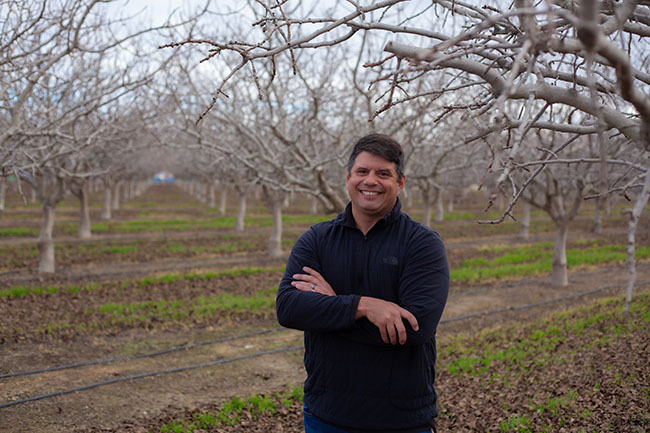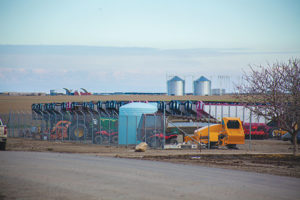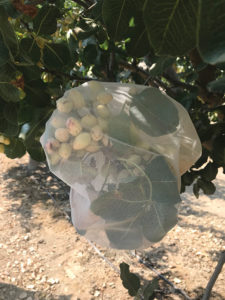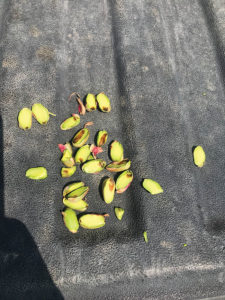
Jan/Feb 2022
The many hats of Joe Coelho
The Coelho family is a multi-generational farming family, and even the name ‘Joseph Coelho’ is on its sixth generation. But a story that began with a Portuguese immigrant, Jose Francisco Coelho II, checking in at Ellis Island with $10 in his pocket and a mission to find his cousin in California, has turned into a large, family-farming legacy.
Next to that is Coelho’s position as an agronomy manager for Maricopa Orchards, a sizable family-owned operation that consists of a much larger portfolio of almond and pistachio, which Coelho manages, and spans the majority of California’s Central Valley from Merced to Kern counties.
Being involved in a vast amount of acres of farmland means Coelho has his work cut out for him.
Coelho Farms, Linda Vista, Terra Linda
What is now the expansive Coelho family farm started with a laborer milking cows, whose children (Joseph III and siblings) would later purchase a property in Riverdale and build a dairy in the 1940s known as Coelho Farms. The Coelhos also purchased land in what would later become the Westlands water district, known as Linda Vista Farms, a diverse row crop farming operation. The following generation (Joseph IV, siblings, and other first cousins) would follow the same path and create their own farming business legacies, founding Terra Linda Farms in the early 1980s.
The family still has the Coelho Farms dairy, as well as Linda Vista Farms, managed by Coehlo’s father and cousins, but recently the cows were sold off, and a large amount of the land has been transitioned into pistachios.
“It happened last April, after 80 years or so,” said Coelho, “and it was a big change. We watched as they auctioned off the cattle and hauled them off. It was surreal.”
In the 1980s, Coelho’s father still managed the dairy, but began to farm row crops under the Terra Linda Farms banner. Dirt was cheaper, as was water, and allocations were dependable, allowing for diversification in the portfolio.
Since then, the story has changed a bit, and more land has been converted into more permanent plantings to make the most out of the water and the profitability of the ground.
“It’s a tough deal. We routinely receive very little to 0% water allocations in Westlands,” Coelho said. “You have to have well water, and then you have to take the negatives with the well water. The west Fresno County well water is extremely deep and full of salt – particularly, sodium and boron.”
Since pistachio is more salt tolerant than other tree nuts, having a mix in the portfolio is beneficial. Allocation of surface water is routinely prioritized to salt-sensitive crops like almond, and salt-tolerant crops receive inferior well water.
“Pistachio seems to tolerate sodic soils more than it tolerates boron-laden soils,” said Coelho. “Gypsum and calcium and such are pretty standard, as are age-old approaches to sodium management, but you still need water to leach it.”
Boron is a more complex problem that requires large, in-season leaching fractions for drainage and management. Coelho is a member of his family’s farm, and primarily assists in the management of the permanent nut crops in west Fresno County. He also actively works with his brothers to farm their personal operation known as California Farming Co.

Maricopa
Coelho’s primary occupation is as Maricopa Orchards’ agronomy manager. Among many duties, he manages an internal research and development team where he conducts independent research and collaborative work with university and governmental professionals. His early farming experience in strawberry production, where he ran a major variety test plot for several years and earned a reputation in fumigant research, fertility research and operational R&D, shaped how he farms fields today.
“I try to take a research-based approach to production ag,” he said. “A lot of adjustments and new practices come out of the research analysis that we do.”
The farm is often open to University of California (UC) Cooperative Extension for research, in addition to Coelho running his own experiments. He recognizes the array of resources available for research, even if it’s something as simple as a decrease in elevation from one end of the farm to the other.
This is the case at his office in Cantua Creek, located on a very large contiguous nut farm, where there is a 300-foot fall. In a single season, part of the ranch will have adequate chill and the other none. This creates a vast amount of variability from one side of the ranch to the other in terms of crop grades and yields, pest development models and their control timings, and harvest timings. With a set number of spray rigs and harvesters, many management questions circulate – where to start, what to do, how to tell the differences between one area and another?
“Managing across a contiguous ranch like this and being able to do analytics that are topographical and elevation related has been interesting to entomologists, plant physiologists, and to me,” said Coelho.
In a second year of collaboration with Barbara Blanco-Ulate of UC Davis and others, the group is well on their way to understanding crop development through several metrics as influenced by temperature variability within a field caused by elevation changes.
Research
Coelho wears multiple proverbial hats in farming both personally and professionally, but research is taking a front seat on these farms.
“Just to look at this farm from one side to the other, it’s always hard to make decisions on things. But, sometimes, they can be so easy,” he said, in reference to one particular problem the industry might be ignoring.
In almonds, there’s been a lot of questioning about why industry yields and kernel sizes are off. More acreage can help boost record-setting annual yields, but the decrease in yield has some people baffled. Coelho admits it’s a difficult question that has been given many different guesses, and not the least of which are lack of quality water, extreme summer temperatures and overall stress.
“In the last five years, we’ve had a lot of summer shade due to fire,” Coelho said. “That’s a big deal because it blocks red and blue wavelengths of light, which is essential in photosynthesis during bud differentiation in almond.”
Trees want to store as much starch as possible going into the winter, but certain factors determine how much the tree is actually able to store. A primary influence is temperature, which regulates the amount of photosynthesis the tree can produce. If the reduction of that light is resulting in photosynthesis reduction, then the quantity of stored starch in the winter is going to be lower.
The UC Davis Carbohydrate Observatory, founded six years ago by Maciej Zwieniecki, explores the content of carbohydrates in deciduous trees, and Coelho enrolled many of his ranches in the program in attempt to understand the influence of temperature and light on carbohydrate content and, subsequently, crop yield. Zwieniecki’s data shows a downward trend of wintertime stored starch across the many almond orchards involved in the study, possibly indicating a reduction of photosynthesis due to impared light from smoke, as described by former Extension advisor, David Doll.
“We’ve been sitting in smoke for five years, and that’s something I think the majority of people aren’t thinking about, and we really should be,” said Coelho.
Pistachio is known for a significant chill requirement, however, the verdict is still out whether smoke cover affects pistachio yields. Coelho has for the past six years conducted collaborative research on the use of kaolin clay and other sunscreen products applied in winter, as well as summer, to protect against sun and heat and their influence on carbohydrate content and yield.

IKD
Affecting pistachio, though on a cryptic level, is internal kernel discoloration (IKD), which Coelho discovered in Golden Hills in many growers’ fields several years ago.
Long studied since the mid-1980s and thought to be caused by insects with piercing mouthparts, Coelho ran his own experiments in the field to determine if this was true, considering it was appearing in a startling amount of the nuts with no indicators of insect damage.
“There was no way insects were causing damage at the level of IKD we observed. I spray, we’re very diligent on our checks, and we can’t even find the insects. We destroy all their habitat and keep the weeds down, and we’re surrounded by ourselves,” he said.
Using exclusion netting, Coelho wrapped clusters and checked them frequently to make sure they weren’t compromised. When the protected clusters were checked against the unnetted ones, they both had the same amount of IKD, calling insect damage into question.

When affected and unaffected kernels were plated for an assessment of fungus and bacteria, 100% of the nuts with IKD produced Aspergillus niger, A. flavis, and penicillium, while only a portion of unaffected kernels showed the same presence.
Suspecting it’s caused by fungal deposition at bloom, Coelho formed an industry-wide taskforce in January of 2021 to replicate the insect exclusion study, as well as address other potential biological and abiotic causes. More information about this is expected to come out in the coming months.
Grower to grower advice
The industry is always looking for ways to boost yields, reduce inputs and make more money. But Coelho suggests that whatever new practice a grower tries, have a system of evaluation with a control and enough replicates to be sure the results are real. Looking to the neighbor, or in what Coelho calls “window farming”, isn’t a good way to farm, and often a field may have done well regardless of what was applied.
“Using an improper design to test a hypothesis usually leads to false conclusions,” said Coelho.
He explained an example of a poorly designed experiment is taking three blocks of equal size, same location and resources, applying a treatment to one block, and then drawing conclusions based on what happens to the treated block. It’s possible whatever result was observed on the treated block was purely coincidental.
“A focused aim, the right design and replication over space and time is the way to assess the successes or failures of what you’re testing,” said Coelho. “Growers create these false positives, and then the industry runs out and says we should spend money on this or that, and you end up with commercials about ‘the farmer’s secret’ on local radio. It happens all the time, and growers really need to look at it in a proper way to figure it out.”
Pest control – navel orangeworm (NOW) especially – is an area that Coelho suggests growers brush up their knowledge and take responsibility for what is happening in their orchards without purely relying on their pest control advisor (PCA). If growers are having trouble with NOW control, they should have their PCA talk to them about it, but should educate themselves.
“And don’t just let the PCA give an answer. The grower needs to know what some of the answers are,” said Coelho.
The type of trap and lure are important for NOW, and Coelho has come across PCAs who don’t use traps. Some spray at hull split the second it’s seen, or adhere to the “spray on May 1st/May spray” without using any form of analytics or modeling while simultaneously watching crop development.
“That’s not the right way to do it, and there are many things that can be done to dial that in. Really making sure you are getting the proper advice is so important because there is certainly a hierarchy of competency when it comes to PCAs,” said Coelho.
Coelho hopes to continue bridging the gap between university research and grower practices, as well as finding answers to some of the industry’s biggest problems and questions.







